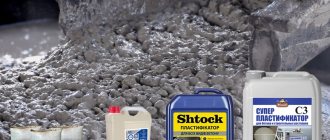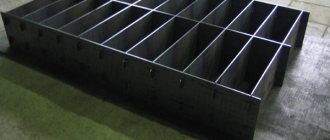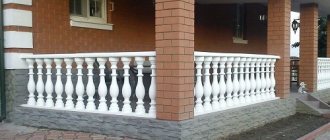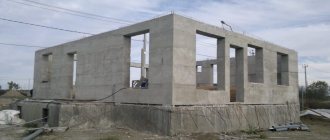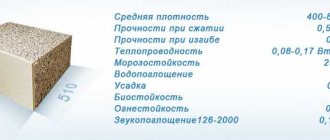The use of plasticizers when mixing concrete and mortars makes it possible to improve the workability of the finished mixture without disturbing the proportions of the mixing water. But in addition to their main purpose, these additives, to one degree or another, have a positive effect on the strength characteristics and improve the appearance of frozen surfaces. The cost of such compositions is high; the question of how to make a plasticizer for concrete with your own hands is often asked on construction forums. The simplest option is liquid soap and other detergents, but their introduction requires caution; if the ratio is violated or unevenly distributed, they do more harm than good.
Description of the material, feasibility of use
A plasticizer for concrete is a dry or liquid additive based on esters: phosphates, phthalic acids, paraffins and various polymer compounds. When interacting with water, they form slightly alkaline solutions, thereby reducing its volume in concrete without impairing fluidity. The use of plasticizers allows you to extend the life of building mixtures. It is a well-known fact that adding water saves a solution that is beginning to thicken from hardening, but few know that changing its ratio with cement leads to a loss of strength by 20-25%. The introduction of special additives at the mixing stage reduces this risk; the solution retains its elasticity for up to 3 hours or more.
Introducing a plasticizer into concrete is recommended primarily for:
- Production of reinforced concrete products, paving slabs, curbs and other processes with vibration laying. This also includes cases when you have to quickly distribute the solution yourself.
- Transporting ready-mixed concrete over long distances.
- Pouring screeds, including heated floors.
- Concreting reinforced structures (the quality of adhesion to metal improves significantly).
Plasticizers are introduced into the solution at the mixing stage (the best option, so they are distributed around each grain of cement and increase its adhesion) or in parts (exclusively if it is necessary to restore mobility). Depending on the intended purpose, professional additives reduce the consumption of binder, enhance its water resistance, accelerate or slow down the hardening process, allow work to be carried out at sub-zero temperatures, or have a complex effect. The main condition of the technology is input in accordance with the proportions and instructions of the manufacturer; exceeding them to a large extent is unacceptable. All modern plasticizers for concrete do not contain toxic or volatile substances, are chemically stable and have a decomposition temperature below the destructive one.
What can replace professional compositions?
No one requires you to make complex chemical compounds at home; well-known substances are used to improve plasticity. These include:
- Detergents.
- Slaked lime.
- Ready-made aqueous solutions of sodium silicates (liquid glass).
- Polyvinyl acetate (PVA glue).
Thus, a self-prepared plasticizer means diluting these substances in the correct proportion and introducing them into concrete at the right time. The savings from such an operation are significant: the minimum cost of 1 kg or liter of professional products is 50 rubles, on average this value coincides with the consumption of 100 kg of cement. Replacing them allows you to reduce the costs of preparing concrete with your own hands significantly (they have lower proportions and prices).
Why are plasticizers added to concrete?
Ordinary water has a plasticizing effect on concrete. The more it is, the more plastic the cement mortar. It spreads well and fills all the voids. But an increase in water in the concrete mixture negatively affects the characteristics of the finished concrete: the strength, frost resistance, water resistance and durability of the structure decrease.
Important!
Concrete mixtures are mixed according to GOST. The proportion of water to concrete (the so-called water-cement ratio) ranges from 0.3 to 0.55. This amount of water is sufficient to hydrate the cement components, but is not at all sufficient to obtain an easy-to-use solution.
Heavy, dense mortar does not fit well into the mold, especially if reinforcement is used. It requires high processing costs, and still, cavities may remain in the finished structure, which will reduce the strength characteristics of concrete.
Interesting!
Concrete mortars are classified according to mobility into 5 classes: from P1 - low-moving to P5 - fluid.
How can we ensure that, without changing the water-cement ratio, we can change the mobility class of the concrete mixture?
The solution to this difficult problem is the use of a plasticizer.
Plasticizers are compositions based on certain types of surfactants.
The use of a plasticizer allows you to make a construction or plaster mortar more mobile without adding excess water to it.
Plasticizers are divided into groups according to the strength of their effect on concrete.
General information
Varieties
Before choosing an additive that is suitable for your case, you should study all the types of additives that exist, as well as their main functions.
Please note that the performance characteristics of the mixture will be improved by modifying its constituent components. Depending on the type of additive, it can even change the hydration of cement in a positive direction, make it resistant to negative temperatures, and also make it more elastic.
Plasticizers for cement mortar can:
- Reduce concentration and moisture saturation.
- During hydration, reduce sedimentation.
- Make it easier for the molds to be filled with the compound, and this will make the laying process easier.
- Make sure that the cement solution that was made in advance is stored for as long as possible.
- Prevent cracking.
- Create the opportunity for steel reinforcement to have better contact with the composition.
- Increases structural strength.
- Reduce the required amount of water.
- They will help ensure that the solution separates as little as possible.
- Create a more mobile mixture.
This is interesting: What is the class and grade of concrete in terms of strength
Advantages and disadvantages of the supplement
Plasticizing additives are dry and liquid. The advantage of liquid additives is ease of dosing and mixing. They easily dissolve in water, which is used when mixing concrete; You can also add them directly during mixing.
Advantages of liquid plasticizers:
- Increases the plasticity and fluidity of the mixture.
- They improve workability and reduce the cost of vibrating concrete.
- Mixtures with a plasticizer, due to their mobility, fill even densely reinforced formwork well without forming voids.
- They contribute to the compaction of the concrete mixture, and the concrete is dense and durable.
- Increases the water resistance and frost resistance of finished structures.
- Reduces cement and water consumption. This means that with a plasticizer it is possible to obtain a concrete class higher than that declared, so you can use cement of a lower grade or reduce its amount by 10-15% without loss of strength. (For example, when using the additive for heated floors CEMMIX CemThermo, the declared strength of concrete is achieved already at the age of 10 days).
- Improves adhesion to reinforcement.
- They improve the mixing of cement mortar components, prevent the mixture from separating and settling of aggregates.
- Increase the time of working with the solution. Concrete mortar without additives begins to set within 3–4 hours, which is inconvenient if it needs to be transported. Adding a plasticizer solves this problem.
- Special plasticizers for heated floors compact the screed and increase heat transfer.
Disadvantages of plasticizers:
- Plasticizers in powder form must be dissolved in water in advance.
- A large amount of plasticizers causes the concrete to take too long to set.
- Plasticizers need to be purchased. But by spending money on the purchase of these additives, we simultaneously save money on cement, water, and electricity required for processing concrete.
Mortar for paving slabs
The composition of concrete for paving slabs contains several ingredients, including basic and additional ones.
Cement
Among the main components, cement plays a special role. There are several grades of cement, but cement grades ranging from 300 to 700 are considered suitable for the production of paving pavements. These indicators indicate the degree of compressive strength. The best option, and the most commonly used, is cement grade M500.
Mortar table with different grades of concrete
When purchasing cement, pay attention to several factors:
- Manufacturer.
- The consignment.
To avoid problems with the characteristics of this material, it is always necessary to buy the same batch of cement.
As for the manufacturer, there should be only one. Each manufacturer produces the material using its own technical process, so the material may vary slightly in color.
This can be avoided if you use cement from the same batch and from the same manufacturer.
Crushed stone and sand
In addition to cement, the solution contains crushed stone or sand. To improve the quality of the finished product, crushed stone is used, the fraction of which is 5–10 mm.
Price for crushed stone fractions 5-20 mm
When producing paving slabs in large quantities, in addition to the fraction, it is necessary to take into account frost resistance. The best option is to use crushed granite.
As for sand, it is no less important than other components. For the solution, you usually take clean sand that does not contain any impurities.
If the sand is slightly of poor quality, it can be sieved. The presence of clay should not exceed 5% of the total amount.
Plasticizers
Additional elements include a plasticizer and a dispersant.
At their core, both a dispersant and a plasticizer are mineral additives that work to improve the quality of the product, and in addition, it significantly simplifies the formation of paving material.
Table of plasticizer proportions
In addition, the finished product acquires waterproof qualities and, accordingly, durability. The use of mineral additives increases the strength of the finished material by 2 times. Frost resistance and elasticity indicators increase. A plasticizer and dispersant are used to achieve a glossy finish.
If you make paving slabs with your own hands, then in addition to these additives you need to add dyes.
On an industrial scale, iron oxide pigment dye is used. Only those dyes that meet certain criteria are selected:
- Do not fade when exposed to ultraviolet rays.
- Do not collapse under unfavorable climatic conditions.
The dispersant helps to grind any component until a homogeneous composition is obtained.
If the manufacturing process involves the use of Polish technology, then the dispersant must be dissolved in hot water, and only then added to the solution. The plasticizer is not so capricious; it is added in dry form.
A dispersant is always used for the first layer, and a plasticizer is reserved for the second layer. Regarding cement, additives should not exceed 0.15%.
Alternatives to plasticizer
Several types of additives are used as plasticizers for concrete: PVA-MB glue or PVA dispersion, lime or household detergents.
PVA glue makes concrete more flexible, durable and increases adhesion. Its disadvantage is the need to add it to the solution in large quantities (from 5 to 20% by weight of dry cement). PVA is used when mixing plaster under tiles.
In plaster mortars, lime is used as a plasticizer.
The properties of liquid soap are less obvious because the exact composition of this additive is not known.
Ash
The last folk supplement that deserves attention. At first glance, ash does not inspire confidence, but keep in mind that it is an environmentally friendly product. A small amount of ash helps make concrete strong and flexible. This mixture is perfect for renovation work in an apartment or private house.
As you can see, there are many folk additives that help you obtain professional concrete at home. Which recipe to resort to is up to you. The main thing is to remember something else: in the pursuit of cheapness, it is important not to forget about quality and further operating conditions. This will help you find a middle ground.
Liquid soap or plasticizer? Why is liquid soap used instead of a plasticizer?
Despite the fact that buying a plasticizer helps save money on the purchase of consumables, some builders decide to save even more and use liquid soap or other detergents as an additive to the concrete solution:
- washing powder;
- shampoo;
- dishwashing detergent.
At first glance, the logic is clear: many plasticizers are based on surfactants (surfactants), just like household detergents. In addition, they cost less than plasticizers and are dosed more economically, so it seems that using liquid soap is better.
Liquid soap and plasticizer: the fundamental difference in composition
What is the difference between liquid soap and plasticizer? Can it replace plasticizer?
The plasticizer was developed in the laboratory as an additive for concrete and tested before going on sale, so there is accurate, verified information on how to dose it and what properties it imparts to concrete.
Household detergents are developed for completely different purposes, and accordingly, they must have certain characteristics that meet these purposes.
There are a huge number of varieties of surfactants, which are made from raw materials of mineral or plant origin and are divided into four main groups:
- anionic;
- cationic;
- amphoteric;
- nonionic.
As a rule, plasticizers include anionic surfactants. In detergents, anionic surfactants are combined with amphoteric or nonionic ones.
The concentration of surfactants in detergents is indicated approximately, and we will never be able to know exactly how much of any surfactant is in liquid soap or shampoo. Any statements by experienced builders that detergent X should be added in, say, 50 g per bag of cement, do not apply to product Y, since the compositions of detergents differ greatly from each other.
Detergents contain a large number of auxiliary components; Even dishwashing detergents now contain glycerin, emollients and other ingredients that are not needed in concrete. How they will affect concrete is not known, since no one has conducted such tests.
But the main problem with liquid soap is the chloride salts in the composition.
Sodium chloride is used in detergents as a cheap thickener for anionic surfactants. But it is not useful for concrete, since it promotes corrosion of reinforcement and the appearance of efflorescence on the surface of concrete.
What problems can be caused by using liquid soap as a plasticizer?
Detergents, indeed, make the concrete mixture more plastic and prevent its delamination and sedimentation of aggregates (sand and crushed stone), but this occurs with the entrainment of air into the solution. The result is less dense concrete with reduced strength, as a laboratory experiment clearly demonstrates.
Compressive strength of concrete. Laboratory experiment
4 samples were made with the expected concrete class B15, of which:
- the solution is made according to GOST;
- 25% more water was added than required by GOST;
- 50% more water was added than required by GOST;
- water was added according to GOST, liquid soap was used as a plasticizer.
After production, the samples were matured in a chamber for 3 months, then they were weighed and tested.
It turned out that the sample with detergent is the lightest (with the same sample volume), which means its density is reduced. In addition, even an increase in water by 50% did not result in such a critical reduction in strength.
Important!
Problems caused by the use of liquid soap will not appear at the stage of mixing and laying concrete, but much later. Wet, crumbling concrete and rusty reinforcement will attract attention when it is no longer possible to change anything. Are the small savings worth the hassle?

